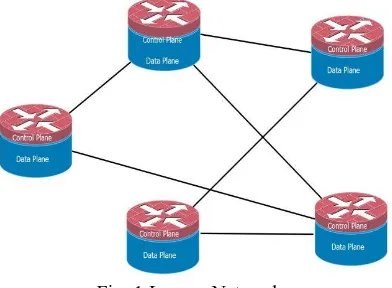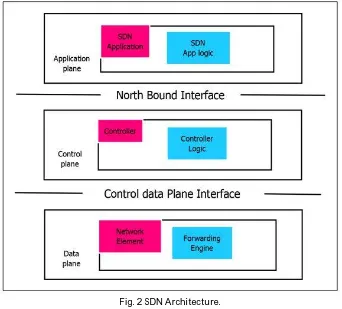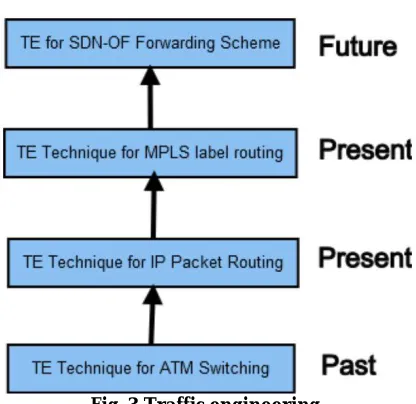A Survey on Traffic Management in Software
Defined Network
Santosh Kumar
Assistant Professor, Dept. of CS&IT, Babasaheb Bhimrao Ambedkar University (A Central University) Satellite
Campus Amethi, Uttar Pradesh, India.
ABSTRACT: Intoday’s stage, controlling and handling physical networks becomes hard working and a complex task as the user requirement changes rapidly. Software defined networking is providing the different way network are design and management. Networks today offer tolerance but at higher complexity. Internet traffic volume constantly growing due to transfer of information between users, increase in demand of resources and high quality of services according to application needs makes network congested, resulting in delay and packet loss. Software defined networking is providing the different structure to network structure, design and management. It has two main characteristics, first it separates the control plane from the data plane, means decouple the controland data plane. Second, it centralizes the control plane, so that a software control program can control many switches.
KEYWORDS: SDN; Traffic Engineering; Openflow; Interface; OSPF; MPLS
I. INTRODUCTION
Software Defined Networking is a technology where network is managed by software program. It is an approach, that allow network administrator to control the network from a single point, a centralized controller. Current network or legacy network architecture is mostly depended on hardware. Date plane and control plane are tightly coupled shown in fig. 1. Where data plane and control plane work together in each device.
Control plane: Control plane controls the exchange of packet that is how, what and where packet should be send. All these works done by layer three switches (routers) and layer two switches by running respective protocols.
Data Plane: Data plane where action is takes place which is governed by control plane. It includes routing table, forwarding table and queue etc [1].
Fig. 1 Legacy Network
II. SDN ARCHITECTURE
Software Defined Networking [1] is a new architecture that is dynamic, adaptable, costeffective, logically centralize and manageable, making it ideal for the flexible, dynamic, high-bandwidth nature of today’s applications. It basically does two tasks, first, it separates the control plane and data plane; and second logically centralize the control plane. So that, network administrators can easily handle the network.
Fig. 2 SDN Architecture.
Figure 2 describes a logical view of the SDN architecture [1]. There are mainly three layers. At bottom, there is a data plane consisting of network elements, SDN data path (not shown in the figure) and forwarding engine. In the middle layer, control plane consists of SDN controller and SDN control logic, and at the top there is application plane consisting of the SDN application logic, which communicate their requirements via North Bound Interface (NBI) Drivers. Network intelligence is (logically) centralize in software-based SDN controllers, which maintain a global view across the network. So, network administrator can control over theentire network from a single logical point, which simplifies the network design and operations. It also simplifies the network devices, as they don’t need to understand and process thousands of protocol standards, but they only have to follow instructions from the SDN controllers, that is created by network administrator. One of the benefit is, it has a centralized intelligence, so administrator can update network behaviour in real-time (if needed) and configure new applications. By centralizing network state in a control layer, SDN gives network administrators the flexibility to manage, configure, secure, program and optimize network resources via easy, automated, and dynamic SDN programs.
1. Data Plane
2. Control Plane
The control plane is the part of a network that carries signaling traffic and is responsible for routing and configuring data plane. Control packets originate from or are destined for a switch Functions of the control plane include system configuration and management. “The control plane is the ‘brain’ of the SDN network. Control plane is responsible for adding, removing, and updating the flow rules in data plane switch that can decide the behavior of the networks.”
3. Application Plane
The application plane comprises one or more applications, each of which has exclusive control of a set of resources exposed by one or more SDN controllers. User can directlyinteract with it and decide the behavior of the network in run time.
4. Control to Data Plane Interface
It is like a bridge between SDN controller and SDN data plane which give control of all forwarding operations, statistic reporting and event notification. OpenFlow protocol used to serve this purpose.
5. Northbound Interface
It is the interface between SDN application and the SDN controller. It provides abstract network views and enables direct expression of network behavior and requirement.
6. East and West Bound Interface
In the case of multiple controller base architecture, the controllers become interconnected through this interface for controlling the whole network as a single entity.
III.NETWORK TRAFFIC MANAGEMENT TECHNIQUE
Traffic management is very important mechanism due to wide area network and dynamically resource requirement by end user. This method is to upgrade the performance of data network by dynamically analysing, foreseeing and controlling the behaviour of transmitted information. Following is the techniques used by current networking and steps toward upgrade approach given in fig 3.
1. ATM-based traffic engineering
Asynchronous transfer machine (ATM) is utilized to use maximum utilization of broadband integrated service digital networks(B-ISDN). ATM can transport different kind of services and all data are set in uniform cell. Two different schemesare categorized [4]
a. Reactive: Source node control traffic movement at start of congestion by giving feedback to them.
b. Preventive:Source node don’t hold up until the congestion really happen. This approach is connection oriented and mostly used by ATM communication. There are three ways to perform preventive control ATM [4].
2. IP-based traffic engineering
IP based traffic engineering is based on routing algorithm running in network. That routing optimizesthe path used in forwarding of data [5].
a. The shortest path routing:large network system run interior gateway protocol, forexample, Open Shortest Path First (OSPF) and Routing Information Protocol (RIP). Each link has cost metric according to traffic and application demand. Routers compute shortest path by OSPF and create routing table. A Simple Network Management Protocol gives the data of current network topology and status of system component in network [6].
Fig. 3 Traffic engineering
3. MPLS-based traffic engineering
MPLS is multiple protocol layer switching is protocol independent transport and scalable. Data packet is assigned a label, MPLS operate in between network layer and data link layer. MPLS work by prefixing MPLS header have four field. A 20-bit label value, 8 bit TTL, 3-bit traffic class, 1 bit bottom of stack flag. This explicitly arbitrarily split the movement of traffic through the network, and provides flexibility for routing and forwarding. MPLS works with ATM and IP network protocol [8][9].
a. LSP tunnels: LSP tunnels that are built up by a signaling protocol, for example, the Resource Reservation Protocol (RSVP) [7]. Network resources can be allotted by various LSP tunnel and traffic is divided among tunnel by applying some local policies. Aggregate traffic is delivered to destination through LSP. Above all is the network traffic management technique for tradition network.
IV.RELATED WORK
A. Tootoonchian, Y. Ganjali[10]described Distributed control architectures for OpenFlow. HyperFlow[10] is implementedby extending NOX controller with some new feature and modification. HyperFlow designthe network with distributed controller over the network and logically centralized those distributed networks. This process of logically centralized network can be controlled from onepoint and scalability is improved. HyperFlow is reliable and resilient to network partitioning and component failure. This is guarantee loop free forwarding in network. In the HyperFlowall SDN controller communicate with other SDN controller. All the request and communication served by local controller, by this process the traffic is minimized. Controller mostlygets update by their neighbours. HyperFlow network composed by OpenFlow switches whichis used as forwarding element.
Sushant Jain, Alok Kumar, Subhasree Mandal presented Google project B4[11]: Experience with a Globally Deployed Software Defined WAN[11]. following number of unique characteristics B4 have. 1. Massive bandwidth requirement deployed to modest number of site. 2. Elastic traffic demand that seeks to maximize average bandwidth.
3. Full control over edge server and network.
Sites controller layers consists of network control servers(NCS) hosting both network control application(NCA) and open flow controller(OFC). Network Topology graph in which vertices represents sites andedges represents site connectivity. Flow Group (FG) is general group of applications. A Tunnel (T) is site level path. A Tunnel Group (TG) mapping between set of FGs to a set of tunnels and corresponding their weight. B4 support Traffic Engineering and shortest path routing simultaneously. If TE is disable it can continues its operations. Traffic engineering database maintains keys value for tunnel group, global tunnels, and flow group. TE operation can manipulate TE database entry at one OFC.
Chi-Yao Hong, Srikanth Kandula, Ratul Mahajan, Ming Zhang, Vijay Gill, Mohan Nanduri, Roger
Wattenhofe[12] Microsoft researcher described and present SWAN project(Software Defined WAN). SWAN used to boost
the high utilization in inter datacenter network by controlling whole network with centralized controller. And reconfigure the data plane to match the current traffic demand. Many services rely on low latency and much speed in inter data communication for good user experience and high throughput transfer. All services use different bandwidth at different time, some uses static allocation of link bandwidth. As a result, the network cycles go through periods of peaks and troughs. Average utilization even at busier traffic is about 30 40% and waste of 60-70% link. SWAN a project in which link utilization of WAN link between the data centers is boosted by centrally controlling the network and managing the traffic. Frequently configure and reconfigure the network data plane. SWAN selects a small set of entries that can best satisfy current network demand. It updates this set of entries without disrupting network traffic. SWAN increased its link utilization up to 60.
V. CONCLUSION AND FUTURE WORK
In this paper, we have reviewed literature in the field of traffic engineering for both current hardware oriented network architecture and SDN, and examined some of the Traffic engineering challenges and future directions. SDN give an open space for researcher to further optimise the network. Separation of control plane from data plane simplifies the whole network. Different traffic engineering technique should be included to control and manage the congestion and traffic in the network. Havier data like video, voice and data transfer between data centres increases the congestion over network. We can apply different techniques according to QoS and need. Routing optimisation is one of the main technique to fined shortest path from multiple path. SDN controller do all these works efficiently. Load balancing and controller placement techniques used to draw some load from over loaded controller and that also increase the fixability of SDN
REFERENCES
1. Nick McKeown, “Software-defined networking”. NFOCOM keynote talk 2009
2. Ian F. Akyildiz, Ahyoung Lee, Pu Wang, Min Luo, WuChou “A roadmap for traffic engineering in SDN-OpenFlownetworks”,Computer Networks,Vol. 71, page1-30, 2014.
3. Nunes, Bruno and Mendonca, Manoel and Nguyen, Xuan-Nam and Obraczka, Katia and Turletti, Thierry and others, “A survey of software-defined networking: Past, present, and future of programmable network” IEEE, Vol. 16 Issue. 3, pages 1617-1634, 2014
4. J.J. Bae, T. Suda, “Survey of traffic control schemes and protocols in ATM networks”, Proc. IEEE, Vol. 79, issue 2, page 170–189, 1999.
5. B. Fortz, J. Rexford, M. Thorup, “Traffic engineering with traditional ip routing protocols”, IEEE Commun. Magaz., Vol. 40, Issue. 10, page. 118– 124, 2002. 6. N. Deo, C.-Y. Pang, “Shortest-path algorithms: taxonomy and annotation”, Networks Vol 14, Issue 2, page. 275–323, 1984.
7. Ian F. Akyildiz, Ahyoung Lee, Pu Wang, Min Luo, Wu Chou “A roadmap for traffic engineering in SDN-OpenFlownetworks”,Computer Networks,Vol. 71, page 1-30, 2014.
8. D.O. Awduche, “MPLS and traffic engineering in IP networks”, IEEE Commun. Magaz.,Vol. 37 Issue 12, page 42–47, 1999. 9. G. Swallow, “MPLS advantages for traffic engineering’, IEEE Commun. Magaz.”,Vol. 37, issue, 12 page 54–57, 1999.
10. A. Tootoonchian, Y. Ganjali, “Hyperflow: a distributed control plane for openflow”, Proceedings of the 2010 Internet Network Management Conference on Research on Enterprise Networking, INM/WREN, Vol. 10, p. 3, April 2010.
11. Jain, S., Kumar, A., Mandal, S., Ong, J., Poutievski, L., Singh, A., Venkata, S., Wanderer, J., Zhou, J., Zhu, M. and Zolla, J., “B4: Experience with a globally-deployed software defined WAN”. ACM SIGCOMM Computer Communication Review, Vol. 43, issue 4, pp.3-14.2013.
12. Hong, Chi-Yao and Kandula, Srikanth and Mahajan, Ratul and Zhang, Ming and Gill, Vijay and Nanduri, Mohan and Wattenhofer, Roger, “Achieving high utilization with software-driven WAN”, ACM SIGCOMM Computer Communication Review, Vol. 43, Issue. 4,pages 15-26, 2013.
BIOGRAPHY


